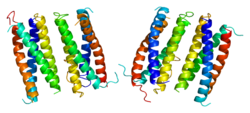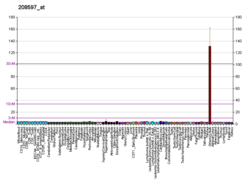Ciliary neurotrophic factor is a protein that in humans is encoded by the CNTF gene.
The protein encoded by this gene is a polypeptide hormone and neurotrophic factor whose actions have mainly been studied in the nervous system where it promotes neurotransmitter synthesis and neurite outgrowth in certain neural populations including astrocytes. It is a hypothalamic neuropeptide that is a potent survival factor for neurons and oligodendrocytes and may be relevant in reducing tissue destruction during inflammatory attacks. A mutation in this gene, which results in aberrant splicing, leads to ciliary neurotrophic factor deficiency, but this phenotype is not causally related to neurologic disease. In addition to the predominant monocistronic transcript originating from this locus, the gene is also cotranscribed with the upstream ZFP91 gene. Cotranscription from the two loci results in a transcript that contains a complete coding region for the zinc finger protein but lacks a complete coding region for ciliary neurotrophic factor.
CNTF has also been shown to be expressed by cells on the bone surface, and to reduce the activity of bone-forming cells (osteoblasts).
Therapeutic applications
Satiety effects
In 2001, it was reported that in a human study examining the usefulness of CNTF for treatment of motor neuron disease, CNTF produced an unexpected and substantial weight loss in the study subjects. Further investigation revealed that CNTF could reduce food intake without causing hunger or stress, making it a candidate for weight control in leptin-resistant subjects, as CNTF is believed to operate like leptin, but by a non-leptin pathway.
Recombinant human CNTF (Axokine)
A recombinant version of human CNTF (rhCNTF), trade name Axokine, is a modified version with a 15 amino acid truncation of the C-terminus and two amino acid substitutions. It is three to five times more potent than CNTF in in vitro and in vivo assays and has improved stability properties. Like CNTF it is a neurotrophic factor, and may stimulate nerve cells to survive. It was tested in the 1990s as a treatment for amyotrophic lateral sclerosis. It did not improve muscle control as much as expected, but trial participants did report a loss of appetite.
Phase III clinical trials for the drug against obesity were conducted in 2003 by Axokine's maker, Regeneron Pharmaceuticals, demonstrating a small positive effect in some patients, but the drug was not commercialized. A major problem with the treatment was that in nearly 70% of the subjects tested, antibodies against Axokine were produced after approximately three months of treatment. In the minority of subjects who did not develop the antibodies, weight loss averaged 12.5 pounds in one year, versus 4.5 pounds for placebo-treated subjects. In order to obtain this benefit, subjects needed to receive daily subcutaneous injections of one microgram Axokine per kilogram body weight.
Xencor patent application raises the disturbing idea that subjects producing antibodies against CNTF analogues may eventually suffer severe adverse effects, as these antibodies could potentially interfere with the neuroprotective functions of endogenous CNTF. The application claims methods of designing CNTF analogues with lower immunogenicity than Axokine based on analysis of affinity of each modified epitope for each of 52 class II MHC alleles, and provides specific examples of such modifications. No such analogues are currently listed in Xencor's product pipeline.
NT-501
NT-501 is a product being developed by Neurotech that consists of encapsulated human cells genetically modified to secrete ciliary neurotrophic factor (CNTF). In a clinical trial, NT-501 demonstrated a statistically significant reduction of photoreceptor degradation in patients with retinitis pigmentosa.
Interactions
Human ciliary neurotrophic factor has been shown to interact with the Interleukin 6 receptor.
See also
References
- ^ GRCh38: Ensembl release 89: ENSG00000242689 – Ensembl, May 2017
- ^ GRCm38: Ensembl release 89: ENSMUSG00000079415 – Ensembl, May 2017
- "Human PubMed Reference:". National Center for Biotechnology Information, U.S. National Library of Medicine.
- "Mouse PubMed Reference:". National Center for Biotechnology Information, U.S. National Library of Medicine.
- Lam A, Fuller F, Miller J, Kloss J, Manthorpe M, Varon S, Cordell B (Sep 1991). "Sequence and structural organization of the human gene encoding ciliary neurotrophic factor". Gene. 102 (2): 271–6. doi:10.1016/0378-1119(91)90089-T. PMID 1840538.
- Bazan JF (Sep 1991). "Neuropoietic cytokines in the hematopoietic fold". Neuron. 7 (2): 197–208. doi:10.1016/0896-6273(91)90258-2. PMID 1714745. S2CID 24161982.
- ^ "Entrez Gene: CNTF ciliary neurotrophic factor".
- McGregor NE, Poulton IJ, Walker EC, Pompolo S, Quinn JM, Martin TJ, Sims NA (Mar 2010). "Ciliary neurotrophic factor inhibits bone formation and plays a sex-specific role in bone growth and remodeling". Calcified Tissue International. 86 (3): 261–70. doi:10.1007/s00223-010-9337-4. PMID 20157807. S2CID 23699865.
- Lambert PD, Anderson KD, Sleeman MW, Wong V, Tan J, Hijarunguru A, Corcoran TL, Murray JD, Thabet KE, Yancopoulos GD, Wiegand SJ (2001). "Ciliary neurotrophic factor activates leptin-like pathways and reduces body fat, without cachexia or rebound weight gain, even in leptin-resistant obesity". Proc. Natl. Acad. Sci. U.S.A. 98 (8): 4652–7. doi:10.1073/pnas.061034298. PMC 31889. PMID 11259650.
- Peterson WM, Wang Q, Tzekova R, Wiegand SJ (June 2000). "Ciliary neurotrophic factor and stress stimuli activate the Jak-STAT pathway in retinal neurons and glia". J. Neurosci. 20 (11): 4081–90. doi:10.1523/JNEUROSCI.20-11-04081.2000. PMC 6772642. PMID 10818143.
- "Axokine from Regeneron (REGN): Unexpected Antibodies and Modest Efficacy in Phase III Study". Press Release. Regeneron Pharmaceuticals. 2003-03-31. Retrieved 2011-08-20.
- US application 2005064555, Marshall S, Barbosa M, "Ciliary neurotrophic factor variants", published 2005-03-24
- "Product Pipeline". Xencor. Retrieved 2011-08-20.
- Talcott KE, Ratnam K, Sundquist SM, Lucero AS, Lujan BJ, Tao W, Porco TC, Roorda A, Duncan JL (April 2011). "Longitudinal study of cone photoreceptors during retinal degeneration and in response to ciliary neurotrophic factor treatment". Invest. Ophthalmol. Vis. Sci. 52 (5): 2219–26. doi:10.1167/iovs.10-6479. PMC 3080173. PMID 21087953.
- "Neurotech's NT-501 Implant Demonstrates Statistically Significant Photoreceptor Preservation in Patients with Retinal Degenerative Disease". Business Wire. 2011-04-11. Retrieved 2011-08-20.
- Schuster B, Kovaleva M, Sun Y, Regenhard P, Matthews V, Grötzinger J, Rose-John S, Kallen KJ (March 2003). "Signaling of human ciliary neurotrophic factor (CNTF) revisited. The interleukin-6 receptor can serve as an alpha-receptor for CTNF". J. Biol. Chem. 278 (11): 9528–35. doi:10.1074/jbc.M210044200. PMID 12643274.
- Schooltink H, Stoyan T, Roeb E, Heinrich PC, Rose-John S (December 1992). "Ciliary neurotrophic factor induces acute-phase protein expression in hepatocytes". FEBS Lett. 314 (3): 280–4. Bibcode:1992FEBSL.314..280S. doi:10.1016/0014-5793(92)81489-9. PMID 1281789. S2CID 39538295.
Further reading
- Sendtner M, Carroll P, Holtmann B, et al. (1995). "Ciliary neurotrophic factor". J. Neurobiol. 25 (11): 1436–53. doi:10.1002/neu.480251110. PMID 7852996.
- Sleeman MW, Anderson KD, Lambert PD, et al. (2000). "The ciliary neurotrophic factor and its receptor, CNTFR alpha". Pharmaceutica Acta Helvetiae. 74 (2–3): 265–72. doi:10.1016/S0031-6865(99)00050-3. PMID 10812968.
- Schooltink H, Stoyan T, Roeb E, et al. (1993). "Ciliary neurotrophic factor induces acute-phase protein expression in hepatocytes". FEBS Lett. 314 (3): 280–4. Bibcode:1992FEBSL.314..280S. doi:10.1016/0014-5793(92)81489-9. PMID 1281789. S2CID 39538295.
- Masiakowski P, Liu HX, Radziejewski C, et al. (1991). "Recombinant human and rat ciliary neurotrophic factors". J. Neurochem. 57 (3): 1003–12. doi:10.1111/j.1471-4159.1991.tb08250.x. PMID 1861138. S2CID 7965554.
- McDonald JR, Ko C, Mismer D, et al. (1991). "Expression and characterization of recombinant human ciliary neurotrophic factor from Escherichia coli". Biochim. Biophys. Acta. 1090 (1): 70–80. doi:10.1016/0167-4781(91)90038-n. PMID 1883844.
- Negro A, Tolosano E, Skaper SD, et al. (1991). "Cloning and expression of human ciliary neurotrophic factor". Eur. J. Biochem. 201 (1): 289–94. doi:10.1111/j.1432-1033.1991.tb16286.x. PMID 1915374.
- Lichter P, Tang CJ, Call K, et al. (1990). "High-resolution mapping of human chromosome 11 by in situ hybridization with cosmid clones". Science. 247 (4938): 64–9. Bibcode:1990Sci...247...64L. doi:10.1126/science.2294592. PMID 2294592.
- Winter CG, Saotome Y, Levison SW, Hirsh D (1995). "A role for ciliary neurotrophic factor as an inducer of reactive gliosis, the glial response to central nervous system injury". Proc. Natl. Acad. Sci. U.S.A. 92 (13): 5865–9. Bibcode:1995PNAS...92.5865W. doi:10.1073/pnas.92.13.5865. PMC 41602. PMID 7597043.
- Yokoji H, Ariyama T, Takahashi R, et al. (1995). "cDNA cloning and chromosomal localization of the human ciliary neurotrophic factor gene". Neurosci. Lett. 185 (3): 175–8. doi:10.1016/0304-3940(95)11254-T. PMID 7753485. S2CID 26711154.
- McDonald NQ, Panayotatos N, Hendrickson WA (1995). "Crystal structure of dimeric human ciliary neurotrophic factor determined by MAD phasing". EMBO J. 14 (12): 2689–99. doi:10.1002/j.1460-2075.1995.tb07269.x. PMC 398387. PMID 7796798.
- Saggio I, Paonessa G, Gloaguen I, et al. (1995). "Nonradioactive receptor binding assay for ciliary neurotrophic factor". Anal. Biochem. 221 (2): 387–91. doi:10.1006/abio.1994.1430. PMID 7810882.
- Takahashi R, Yokoji H, Misawa H, et al. (1994). "A null mutation in the human CNTF gene is not causally related to neurological diseases". Nat. Genet. 7 (1): 79–84. doi:10.1038/ng0594-79. hdl:2433/160721. PMID 8075647. S2CID 5606065.
- Giovannini M, Romo AJ, Evans GA (1993). "Chromosomal localization of the human ciliary neurotrophic factor gene (CNTF) to 11q12 by fluorescence in situ hybridization". Cytogenet. Cell Genet. 63 (1): 62–3. doi:10.1159/000133504. PMID 8449041.
- Robledo O, Auguste P, Coupey L, et al. (1996). "Binding interactions of leukemia inhibitory factor and ciliary neurotrophic factor with the different subunits of their high affinity receptors". J. Neurochem. 66 (4): 1391–9. doi:10.1046/j.1471-4159.1996.66041391.x. PMID 8627290. S2CID 35399535.
- Gutman CR, Strittmatter WJ, Weisgraber KH, Matthew WD (1997). "Apolipoprotein E binds to and potentiates the biological activity of ciliary neurotrophic factor". J. Neurosci. 17 (16): 6114–21. doi:10.1523/JNEUROSCI.17-16-06114.1997. PMC 6568355. PMID 9236223.
- Cargill M, Altshuler D, Ireland J, et al. (1999). "Characterization of single-nucleotide polymorphisms in coding regions of human genes". Nat. Genet. 22 (3): 231–8. doi:10.1038/10290. PMID 10391209. S2CID 195213008.
External links
- Ciliary+neurotrophic+factor at the U.S. National Library of Medicine Medical Subject Headings (MeSH)
- Overview of all the structural information available in the PDB for UniProt: P26441 (Ciliary neurotrophic factor) at the PDBe-KB.
| PDB gallery | |
|---|---|
| Cell signaling: Nervous tissue: Neurotrophic factors | |
|---|---|
| Neurotrophins | |
| GDNF family | |
| Ephrins | |
| CNTF family | |
| Other | |
| Cell signaling: cytokines | |||||||||||||||||||||||||||||||||||||||||||
|---|---|---|---|---|---|---|---|---|---|---|---|---|---|---|---|---|---|---|---|---|---|---|---|---|---|---|---|---|---|---|---|---|---|---|---|---|---|---|---|---|---|---|---|
| By family |
| ||||||||||||||||||||||||||||||||||||||||||
| By function/ cell | |||||||||||||||||||||||||||||||||||||||||||
| Growth factor receptor modulators | |||||||||||
|---|---|---|---|---|---|---|---|---|---|---|---|
| Angiopoietin |
| ||||||||||
| CNTF |
| ||||||||||
| EGF (ErbB) |
| ||||||||||
| FGF |
| ||||||||||
| HGF (c-Met) |
| ||||||||||
| IGF |
| ||||||||||
| LNGF (p75) |
| ||||||||||
| PDGF |
| ||||||||||
| RET (GFL) |
| ||||||||||
| SCF (c-Kit) |
| ||||||||||
| TGFβ |
| ||||||||||
| Trk |
| ||||||||||
| VEGF |
| ||||||||||
| Others |
| ||||||||||






